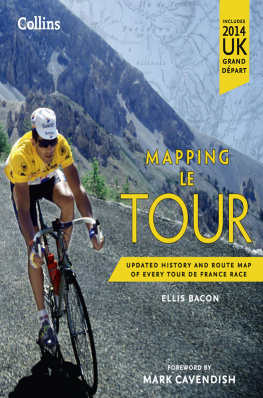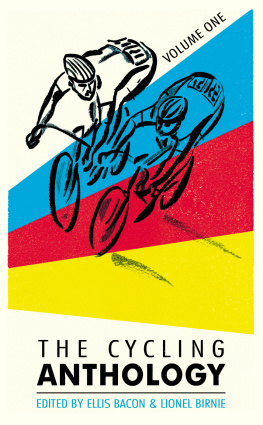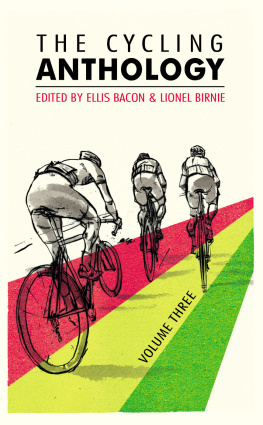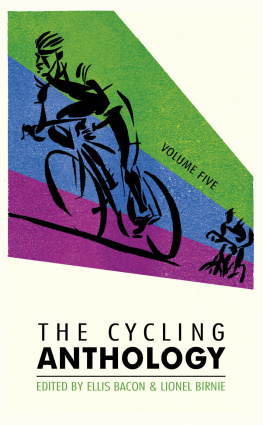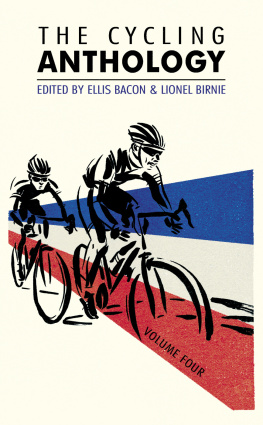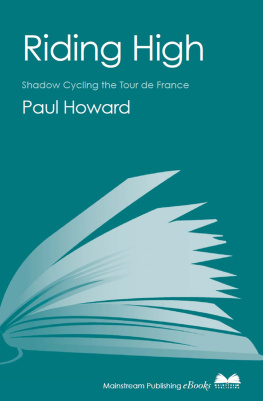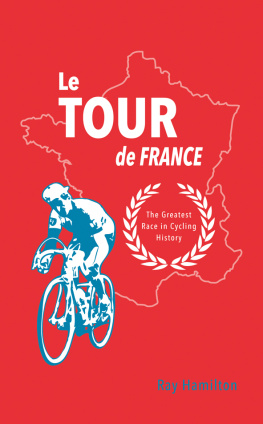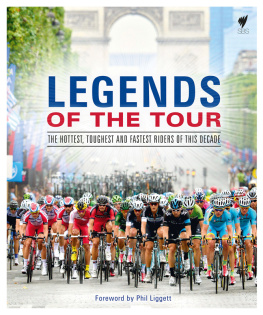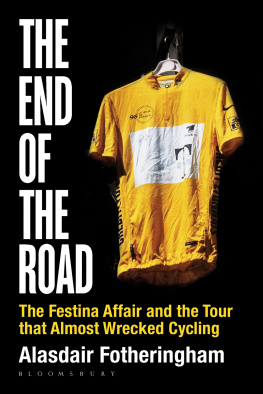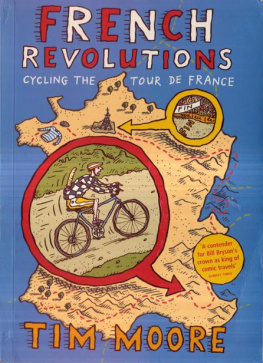CONTENTS
THE NEUTRALISED ZONE
INTRODUCTION BY THE EDITORS
LOOK HOW BIG ITS BECOME
BY SAMUEL ABT
A LIFE OF BRIAN
BY NED BOULTING
THE ANGEL OF THE MOUNTAINS
BY RICHARD WILLIAMS
NERVOUS BUT PREPARED
BY KLAUS BELLON GAITN
ITS ALL ABOUT THE CAR
BY BRENDAN GALLAGHER
THE RELUCTANT PRINCE
BY DANIEL FRIEBE
A MEST GAL
BY JEREMY WHITTLE
NAPOLEON
BY WILLIAM FOTHERINGHAM
THE GREATEST SHOW ON EARTH
BY ELLIS BACON
THE TOUR WINNERS CLUB
BY EDWARD PICKERING
ROCHE AND THE ROOKIE REPORTER
BY RUPERT GUINNESS
A GUIDE FOR THE CYNICS AND SCEPTICS
BY LIONEL BIRNIE
THE DIRECTOR
BY JAMES STARTT
A DOMESTIQUES TALE
BY DANIEL LLOYD
About the Book
Professional cycling is a rich, dynamic and often controversial sport that lends itself to great writing. Some of the most famous and illustrious races were founded by newspapermen and The Cycling Anthology continues this tradition by bringing together the best in the business.
Volume Two is a Tour de France special edition and features original and exclusive pieces by leading cycling writers. ITV reporter Ned Boulting looks at how the Tour made it to our living rooms and into our hearts; pro rider Daniel Lloyd lifts the lid on actually riding a Tour in A Domestiques Tale; Jeremy Whittle examines why, despite drug scandal and infamy, the Tour still intoxicates us; and many more.
About the Authors
Lionel Birnie is a journalist, author and publisher who specialises in cycling. He is the freelance cycling correspondent for The Sunday Times and writes for Cycle Sport and Cycling Weekly, two of Britains leading cycling magazines.
Ellis Bacon is one of Britains most experienced cycling journalists. He is the former deputy editor of Procycling magazine, and has written extensively for Cycling Weekly and Cycle Sport.

This ebook is copyright material and must not be copied, reproduced, transferred, distributed, leased, licensed or publicly performed or used in any way except as specifically permitted in writing by the publishers, as allowed under the terms and conditions under which it was purchased or as strictly permitted by applicable copyright law. Any unauthorized distribution or use of this text may be a direct infringement of the authors and publishers rights and those responsible may be liable in law accordingly.
Version 1.0
Epub ISBN 9781448191673
www.randomhouse.co.uk
Published by Yellow Jersey Press 2014
2 4 6 8 10 9 7 5 3 1
Copyright Peloton Publishing 2013
Each author has asserted their right under the Copyright, Designs and Patents Act 1988 to be identified as the author of their work
First published in Great Britain in 2013 by Peloton Publishing
Yellow Jersey Press
Random House, 20 Vauxhall Bridge Road,
London SW1V 2SA
www.vintage-books.co.uk
Addresses for companies within The Random House Group Limited can be found at: www.randomhouse.co.uk/offices.htm
The Random House Group Limited Reg. No. 954009
A CIP catalogue record for this book is available from the British Library
ISBN 9780224099561
THE NEUTRALISED ZONE
INTRODUCTION BY THE EDITORS
THE TOUR DE France was conceived in 1902 by journalists seeking a way to save their flagging newspaper, LAuto.
With the circulation falling, a crisis meeting was held and the papers young cycling correspondent, Go Lefvre, suggested a bike race around France.
His editor, Henri Desgrange, was not initially impressed, but he soon came round to the idea and the Tour de France was born.
So, too, was the races inextricable link with the written word. Before television and even when radio broadcasting was in its infancy, the French public connected with the race through the pages of the newspapers.
In those early days, covering the Tour must have been a near-impossible job. Daily stage reports were compiled from whatever the journalists were able to see on the road. Their stories were polished and, possibly, embellished before being delivered to an increasingly hungry public to consume with their morning coffee and croissant.
People were hooked on the episodic nature of the Tour and as the drama unfolded the press found it had the power to create heroes. All of humanity was contained in the Tours daily dispatches.
Triumph and disaster. Hope and despair. Good and not so good.
Journalists have always shaped the race. After the Second World War, Jacques Goddet, who founded LEquipe, succeeded Desgrange. He was later joined by Flix Lvitan, who wrote for Le Parisien Libr, and for years the pair ran the Tour.
Very briefly, at the end of the 1980s, the race was directed by men with experience of other industries before Jean-Marie Leblanc took over and, with the bold touch of a master storyteller, gave the Tour arguably its most dramatic moment.
Leblanc, who had written for La Voix du Nord, took the reins in 1988 and decided the following years race should conclude with a time trial from Versailles to the Champs-lyses instead of Lvitans usual showpiece on the famous Parisian boulevard.
Call it beginners luck if you like but Leblancs gamble paid off handsomely. Greg LeMond overturned Laurent Fignons 50-second lead to win the Tour by eight seconds the narrowest winning margin in the events history.
When Leblanc retired, he passed the baton to Christian Prudhomme, who had begun his career as a radio journalist. Although his trade was not the written word, he nevertheless understands the importance of good story-telling, and it shows in the way he has influenced the design of the Tours route in recent years.
For example, the 100th Tour features, for the first time, two ascents of Alpe dHuez on the same day. Only someone with a keen sense of the importance of narrative could have come up with that.
This second volume of The Cycling Anthology is dedicated to the Tour as it marks that milestone. Between them, our writers have covered more than 200 Tours, and ridden one. In giving the writers an opportunity to tell the story they wanted to tell, we hope to have curated a collection as varied and unpredictable as the great race itself.
It is not intended to be a history of the race: rather, it is a series of essays that, hopefully, combine to enhance your understanding of the Tour.
Wed like to thank all our readers for supporting The Cycling Anthology and, if you enjoyed the book, please recommend it to your friends.
Ellis Bacon & Lionel Birnie
remembers the man who ruled the Tour de France with an iron fist for years and who always harboured grand ambitions for the great race.
Felix Lvitan dreamed of taking the Tour to the United States but ended up leaving the organisation in controversial circumstances.
After more than a decade in the wilderness, Lvitan was invited to Dublin for the start of the 1998 race and marvelled at how the scale of the event exceeded even his expectations.
LOOK HOW BIG ITS BECOME
BY SAMUEL ABT
DUBLIN, EARLY JULY 1998: The Tour de France is setting up shop. Buses, bicycles, motorcycles and cars are everywhere in and near the central thoroughfare of OConnell Street. Policemen blow whistles, officials shout orders. Around a corner trundle the three huge vans that are parked near the end of each stage to offer VIP guests a clear look at the finish line.
More whistles, more shouting, more honking. The publicity caravan begins to move along with its plastic floats of ice-cream cones and cheeses.
Next page

